After three hours of driving in a car hired together with the driver, we returned to Hospet and the driver took us to the railway station right when we wanted it – around 7 pm. We had a train to Bangalore at 7.55 pm to catch and it even arrived a few minutes before the time! So, I would like to see somebody complain about Indian trains and their notorious delays.
What both Sneža and I realised on this occasion was the following. This was exactly the same train as the one from Mumbai to Goa. But ... after already one such train experience, one coach experience and some ten days in India, this evening we were not taken aback or surprised at all. Quite the contrary, we entered the train wagon in which we had our berths and settled there with the same ease as if we had entered the first class train in Europe.
I have already described the “second normal class” (https://www.svudapodji.com/en/india-3/) and if you go to the provided link it is possible to see there a couple of photos of this type of wagon. This is an open-space couchette system and this night we had berths that were parallel to the passage. So, we put our backpacks under the lower berth, lay down each one onto her own berth, turned our backs towards the passage, covered ourselves well and slept quite well until the following morning.
The plan was that early in the morning we should be in Bangalore and then we would see how to transfer immediately to Mysore. Once there, we would visit everything we wanted until the evening and then we would take a night coach to transfer to Kochi, a town located in the federal state of Kerala.
To start with, although Bengaluru (this is the official name now; the former name in English which continues to be broadly used is Bangalore) is the capital of the federal state of Karnataka and the seat of the exceptionally big and successful IT industry in India, we did not stay there at all, but like we had planned we bought tickets for the next destination and that was the city of Mysore. It is also located in the federal state of Karnataka and here is where Sneža and I went to next in this state.
As we were travelling by train from Bangalore to Mysore, we passed through several villages and towns, as well as through numerous fields.
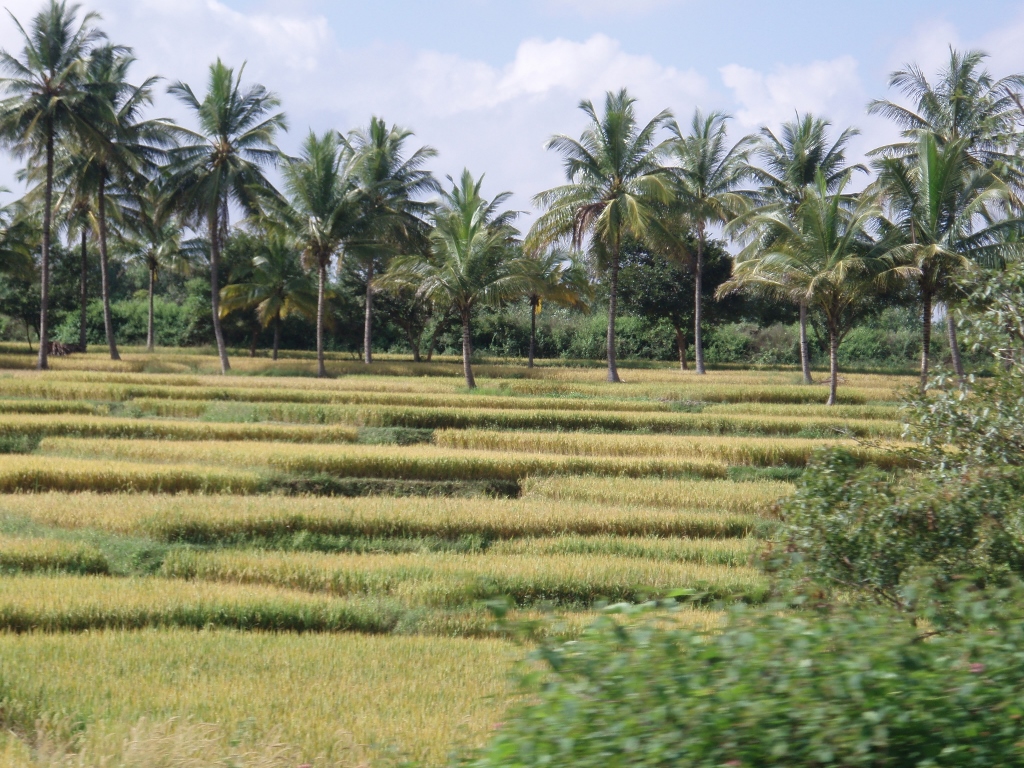 Fields and palm trees between Bangalore and Mysore
Fields and palm trees between Bangalore and Mysore
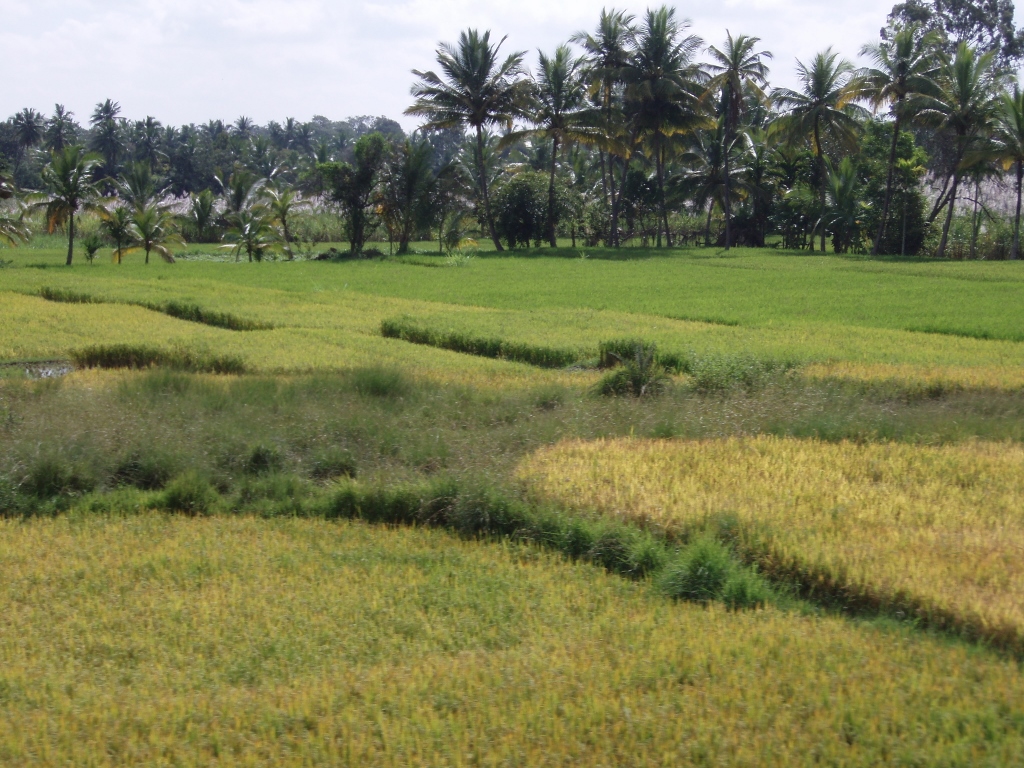 Fields and palm trees between Bangalore and Mysore
Fields and palm trees between Bangalore and Mysore
With few interruptions, Mysore was the seat of the Wodeyar dynasty from 1399 until 1947 when India won its independence. Generally speaking, before the arrival of the Brits and other colonisers, there used to be several states on the Indian sub-continent that were ruled by different dynasties of rajas, sultans and other carriers of royal and imperial titles. When the British came, as the most dominant colonisers, these local rulers practically turned into British vassals. As many as 566 of them had individual treaties with the Brits! When the Brits left, formally speaking, all of these individual states became independent again, but within the scope of the creation of a unique federal state and a republic, their royal and imperial rulers ceded the reign in exchange for keeping their property and getting certain regular monetary disbursements from the state. As the time passed, these disbursements kept going down and since 1971 they have been completely abolished. This led to a situation where some of the palaces have been turned into hotels or the descendents of the former rulers started to be more active in business or some of them entered politics, but this time within the scope of a democratic system that exists in this republic. India is often called the biggest democracy in the world, taking into account that it is the second largest country in the world by the number of its residents, but has a multi-party system.
But, let me go back to the story about Mysore. There is a truly magnificent palace in this city – Amba Vilas Palace which is most often called Mysore Palace and which is nowadays the official seat of the Wodeyar dynasty. The palace was built in the Indo-Saracenic architectural style in the period from 1897 to 1912 after the previous palace had burned to the ground.
Following our arrival in Mysore, the two of us first went to the palace, but actually only walked around the estate in which the palace is situated. This was quite a good decision, since at the beginning of our admittedly brief stay in this city the sky was blue and with some clouds, while later the clouds covered the whole sky and the palace was somehow less striking then.
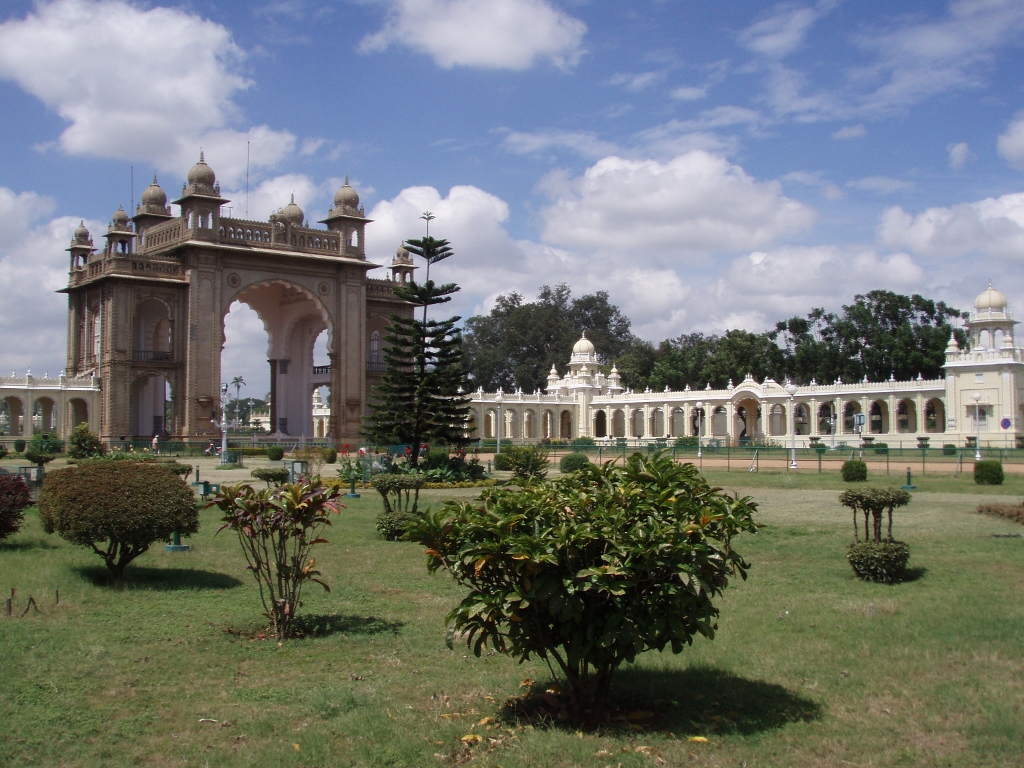 Mysore Palace estate
Mysore Palace estate
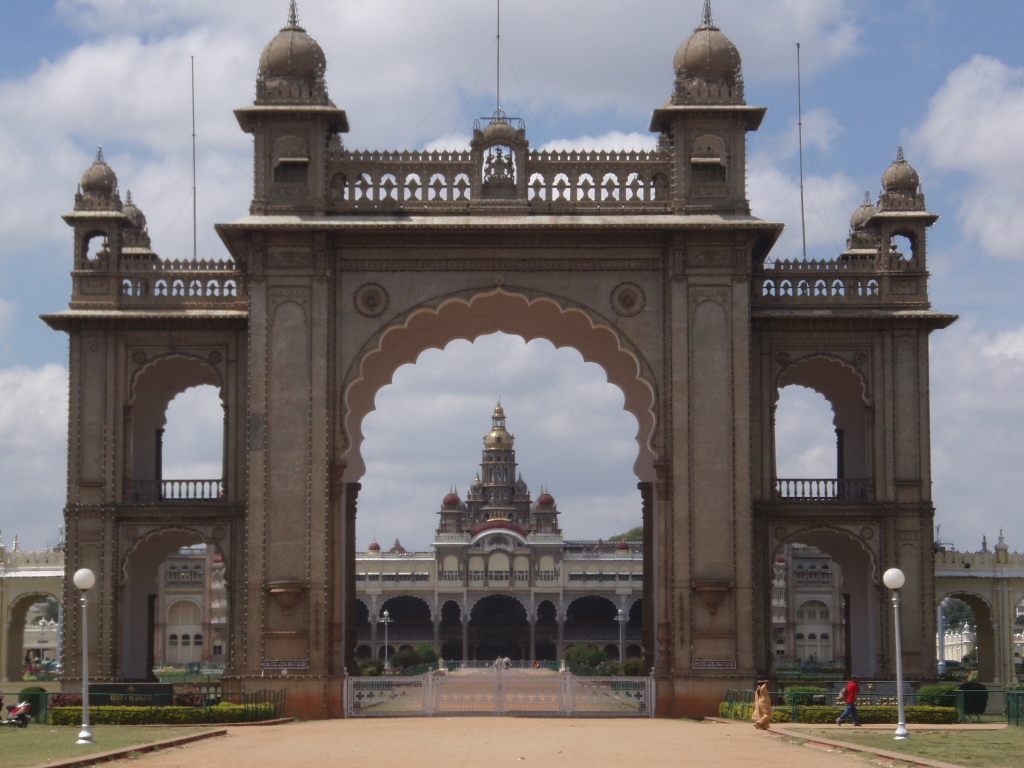 Main entrance and Mysore Palace
Main entrance and Mysore Palace
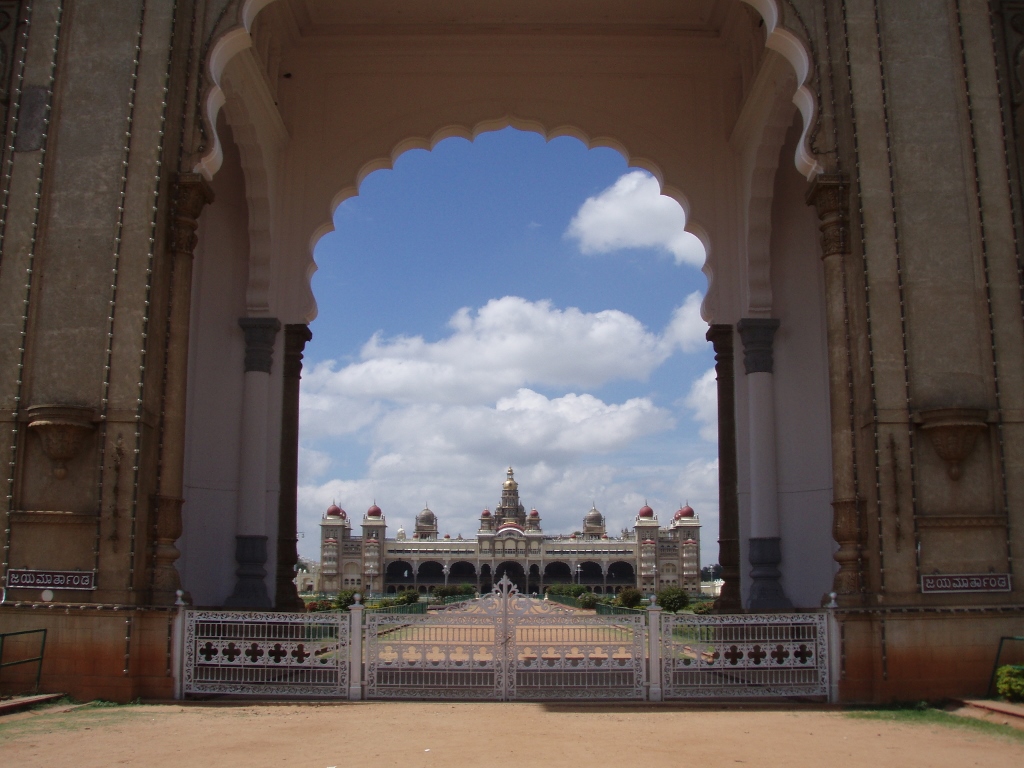 Mysore Palace seen through the arch of the main entrance
Mysore Palace seen through the arch of the main entrance
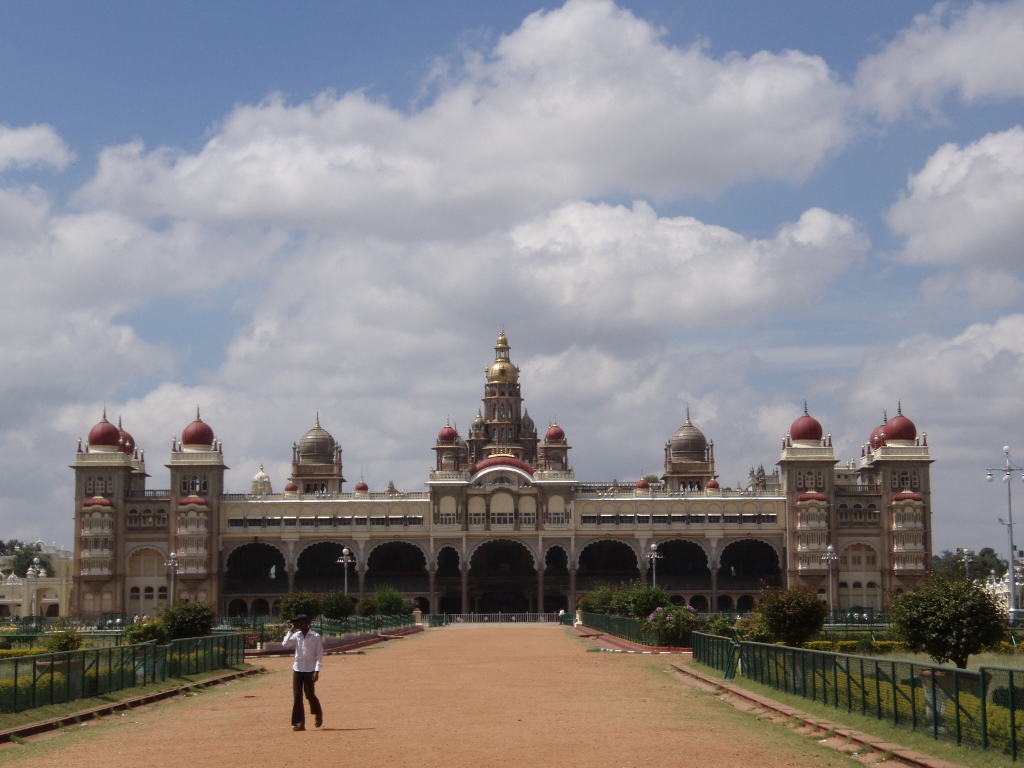 Mysore Palace
Mysore Palace
We left the visit to the interior of the palace for later, since we first went to have a light lunch, after which we wanted to go to the market. It meant walking a little to one side and then a little to the other, but we were not bothered. Along the way, we stopped at a couple of shops that sold fabrics and saris. This was a feast for the eyes. Among other things, Mysore is famous for its silk-weaving and a good part of the best products of this kind could be seen in these shops. Of course, the two of us were sufficiently wise not even to think of buying a sari. No matter how much this type of garment may seem striking, exotic and ravishing, especially when the saris are made of delicate and exquisitely beautiful materials, putting a sari on or better said “installing it onto oneself” entails some serious level of skilfulness that is best acquired if you were born in India or if you grew up there.
In the streets there were a lot of traffic jams and it was particularly lively in one of the main squares which is the Krishna Raja Circle.
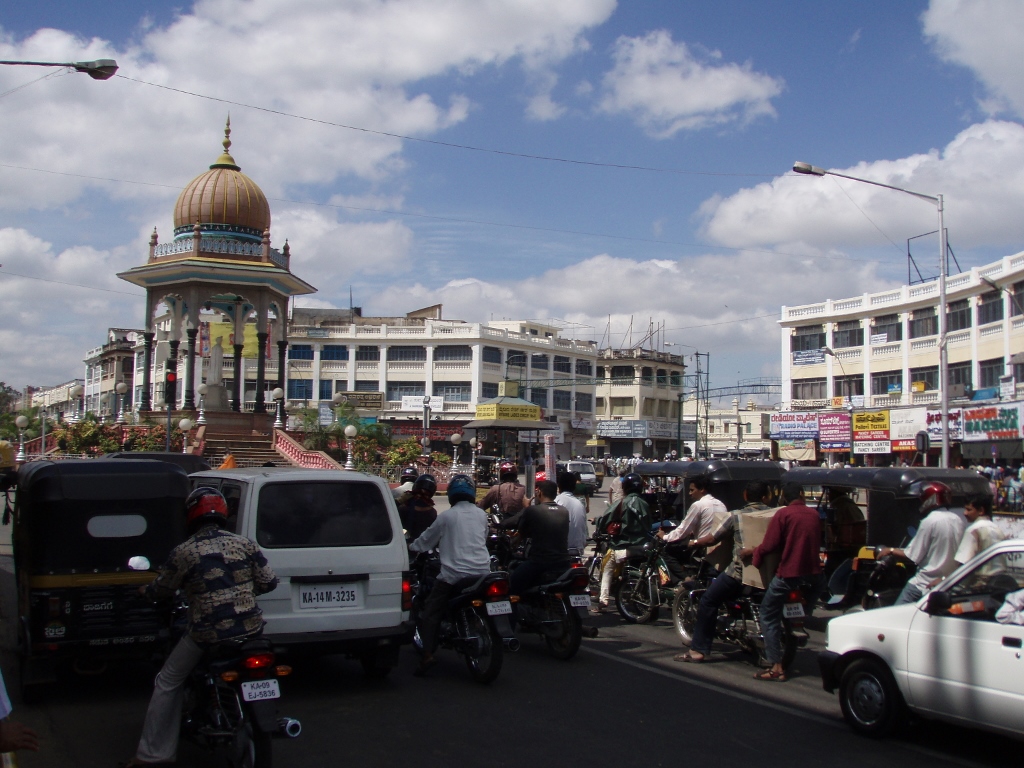 Krishna Raja Circle
Krishna Raja Circle
As an overture to what we were to see in the famous Mysore Devaraja Market, on the pavements we walked along we could see a lot of people selling incredibly long strings of flowers wrapped in a circle as if it were a rope of some kind.
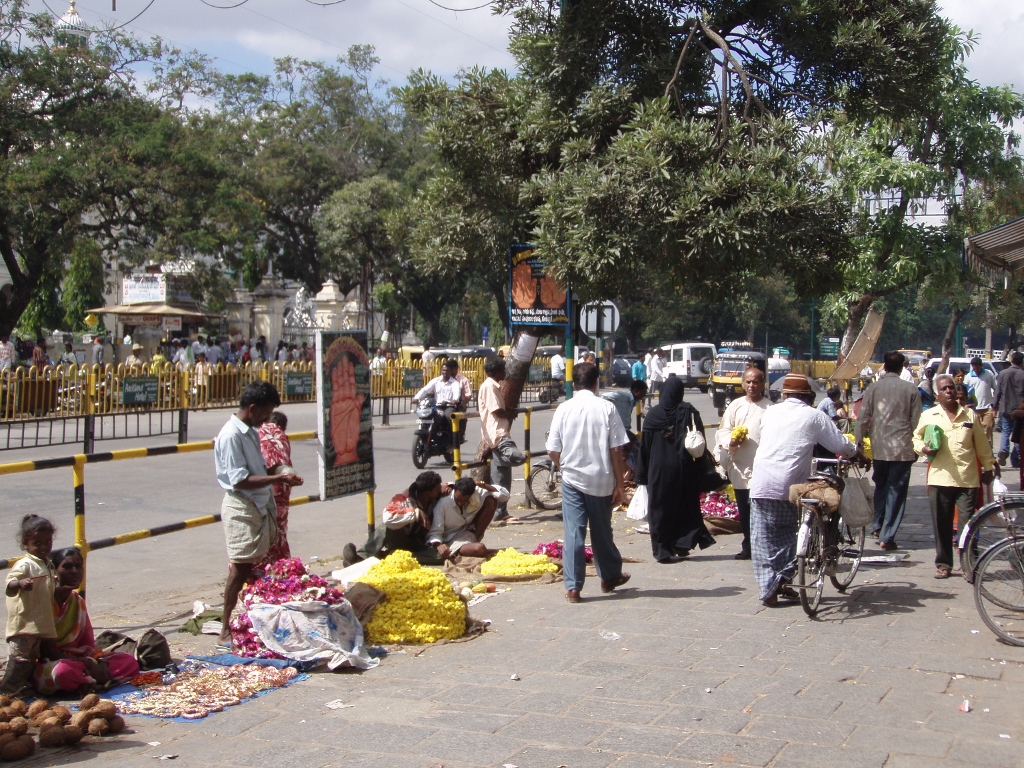 Pavement in Mysore
Pavement in Mysore
The Devaraja Market is among other things famous precisely for the large quantity of flowers that are most often sold in the form of flower garlands.
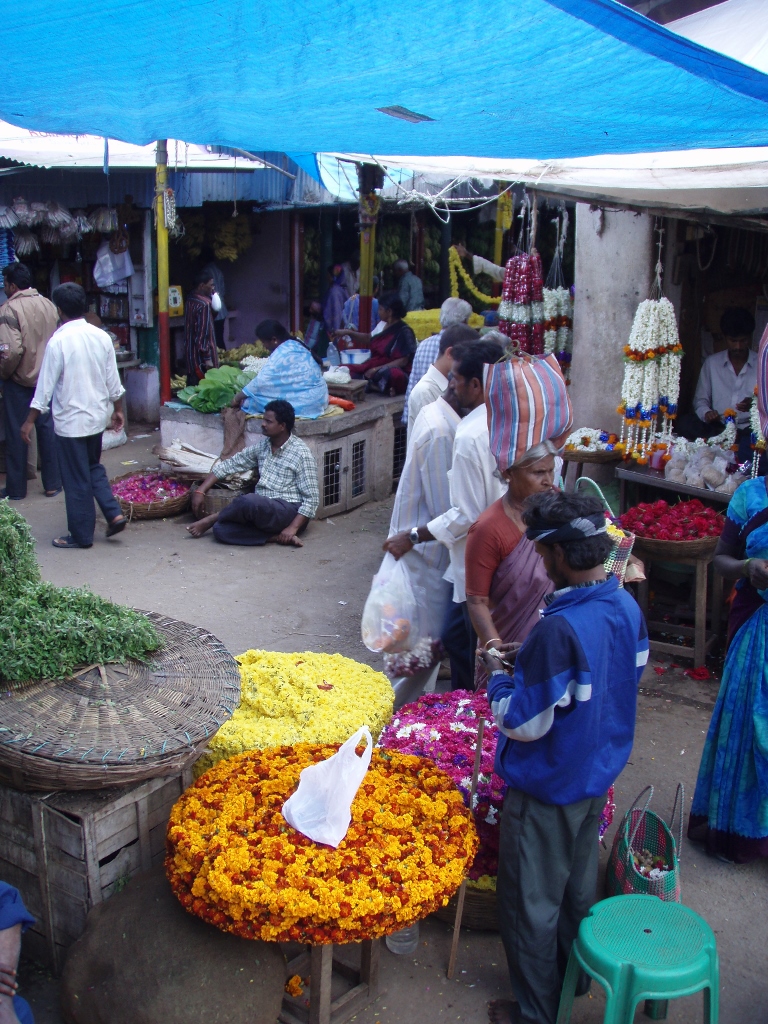 In the Devaraja Market
In the Devaraja Market
It was interesting that we saw only men working at these stands/workshops.
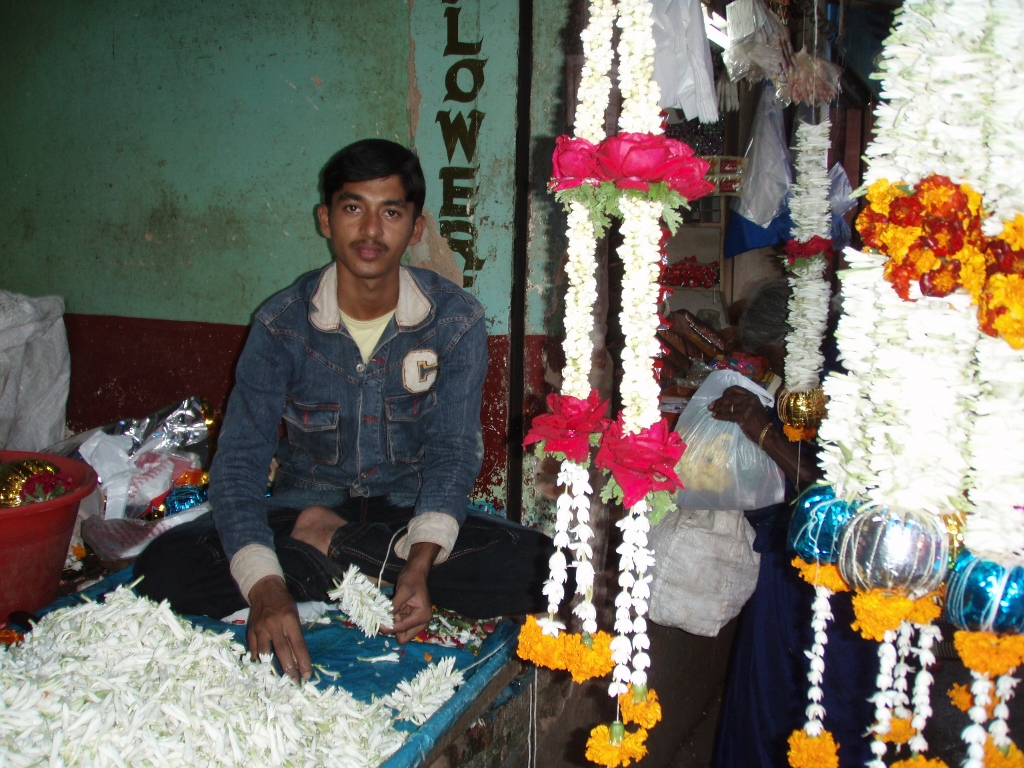 Master for stringing flowers at the Devaraja Market
Master for stringing flowers at the Devaraja Market
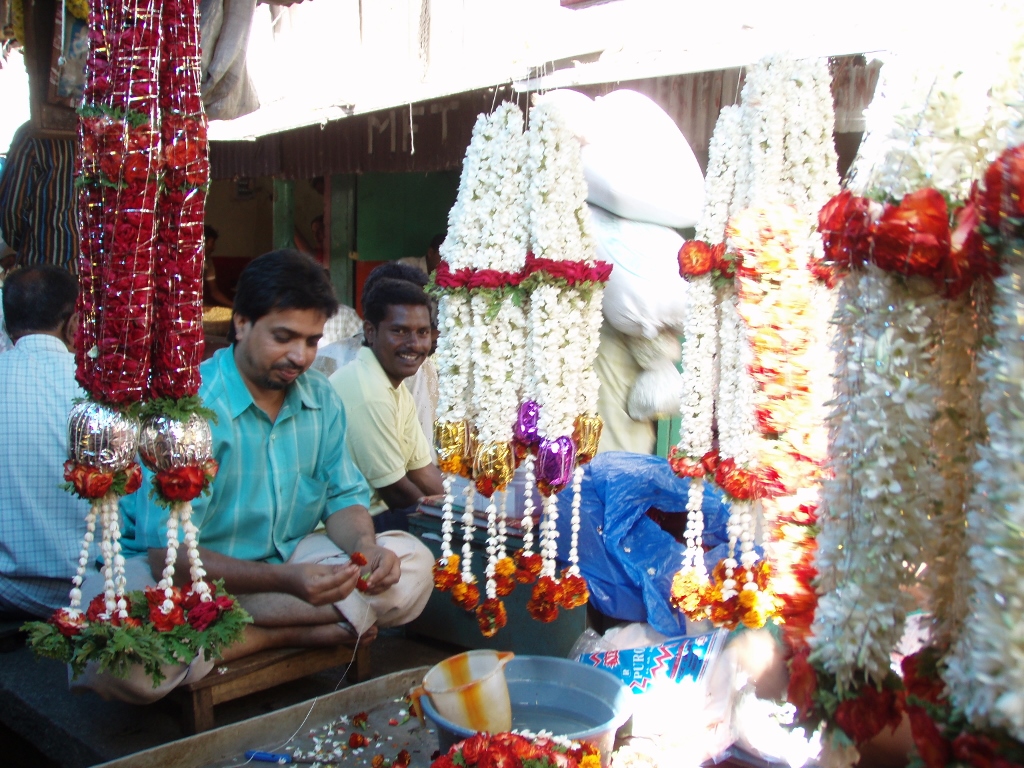 Master for stringing flowers at the Devaraja Market
Master for stringing flowers at the Devaraja Market
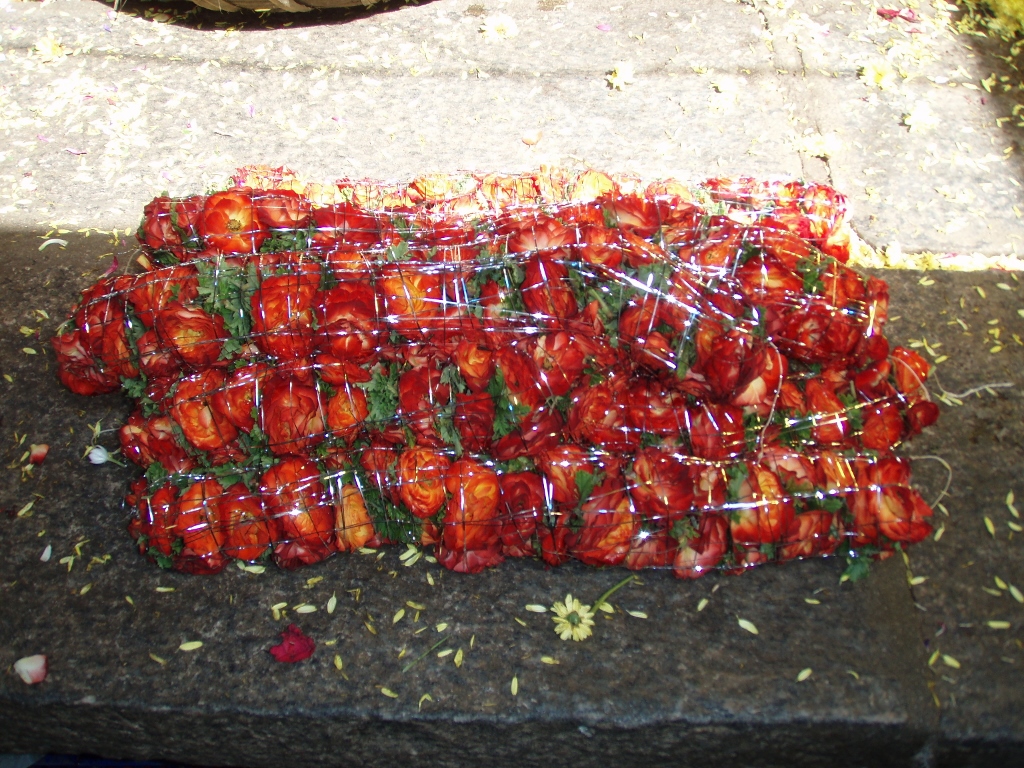 In-between two phases in the flower garland production
In-between two phases in the flower garland production
Can you even presume how wonderful this part of the market smelled? As mesmerised, the two of us walked between the stands enjoying all of this and then one boy who had voluntarily, uninvited, but not too imposing started to be our guide through this part of the market led us also to a shop that constituted a natural extension of these with flowers. This was a shop that sold perfumes, primarily oils made of different flowers, and we did not oppose this in the least. In addition to buying some of those perfume oils (I think that Sneža bought half the shop in order to give these bottles with oil as presents to her Belgrade friends), we truly enjoyed the things these guys showed us in the shop.
One of those things was how to ensure that we have access to the perfume oil during the entire day without taking the bottle with us. Namely, you should make a tiny ball made of cotton wool, soak it in perfume and then place it comfortably into one part of the earlobe which seems almost as if the nature has made it right for this purpose. As the day progresses and the originally applied perfume evaporates, it’s enough that the person who has this tiny ball in her earlobe discreetly and gently taps on the ball with a fingertip thus getting a new quantity of the perfume oil which then she can apply to other parts of the head, neck or the wrists.
The other thing these guys at the perfume shop showed us was how in fact incense sticks are made manually.
In this market, as well as in many other places throughout India, we also saw stands that were selling kumkum or kumkuma. These are strong pigments made of natural materials that are used for social or religious marking of people. This marking usually goes in the form of a dot that is put on the forehead, between the eyebrows, and that dot is called bindi. Bindi is traditionally put on the spot between the eyebrows where it marks the position of the so-called third eye or the ajna chakra. Like everything else in India, the use of kumkum is not as simple as one may think which is already seen by the number of different colours in which it is produced. Namely, there is a whole complex system as to who uses which symbols and how these symbols are applied across the face. Later during our journey we would come across very diverse ways of applying kumkum.
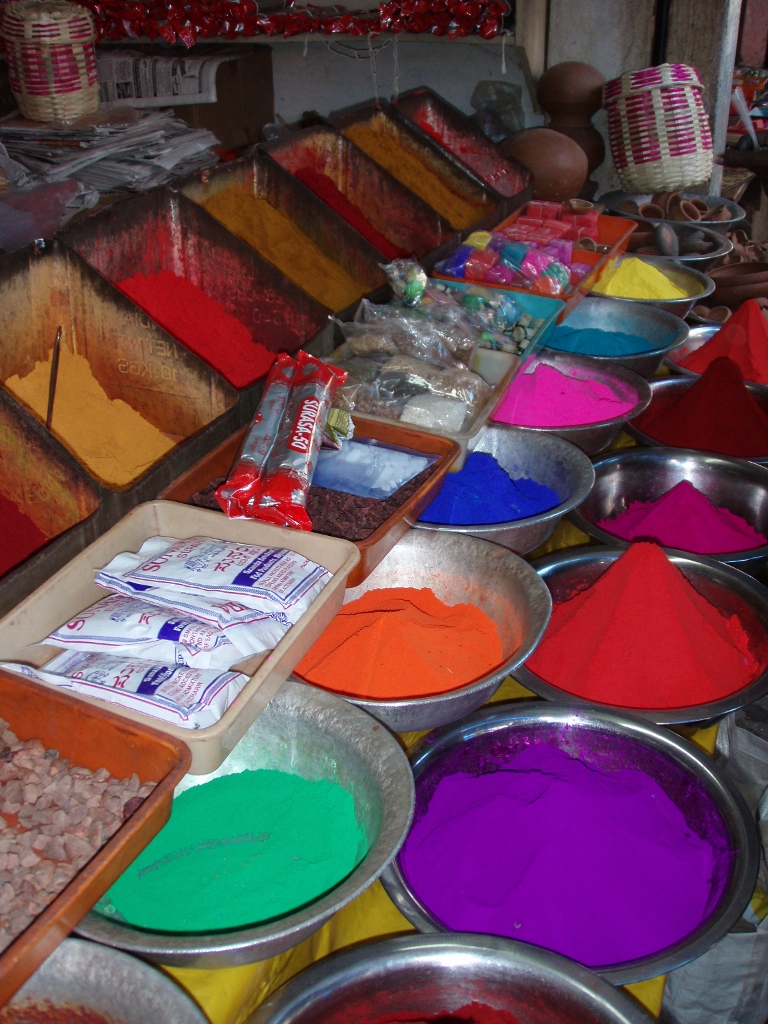 A stand with kumkum
A stand with kumkum
Needless to say, there is also a part of the market where fruits are sold and we passed through there as well.
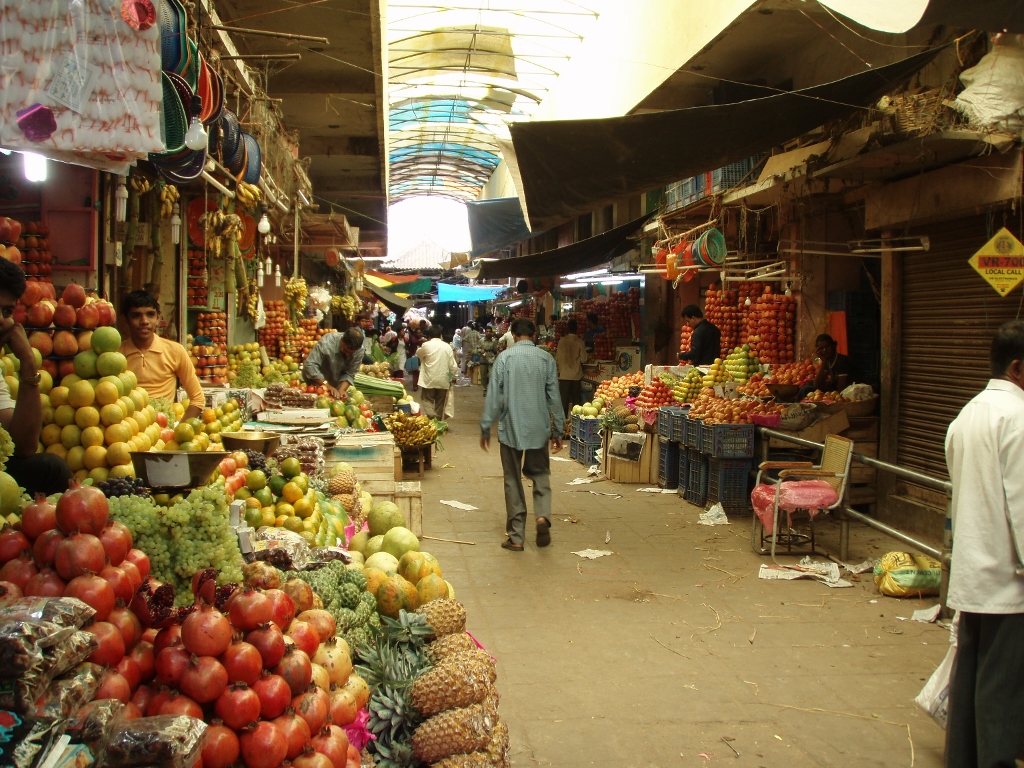 Part of the market with fruits
Part of the market with fruits
We regularly ate fruits, but I must admit that most frequently we ate tangerines since they were the easiest to peal and in this way the most hygienic. I did not find the bananas we tried here in India, which are also easy to eat and do not require any washing or any tools to prepare, very impressive; I had eaten sweeter in some other destinations. However, this day, we came across a cart on the pavement from which they were selling cleaned papaya ready to eat. We decided to take a large piece cut into cubes and this was truly fantastically tasty papaya, perhaps the tastiest one I have ever tried. Still, what was especially interesting was how they were selling it – on a page from a magazine.
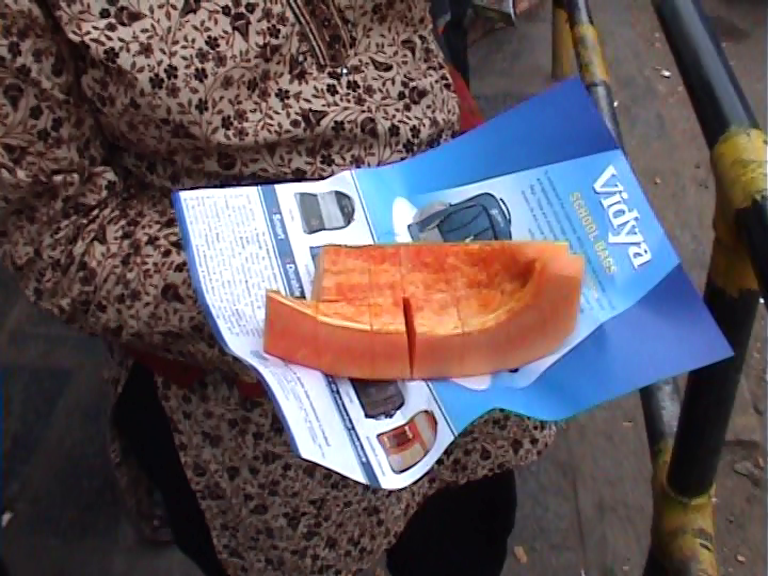 Amazingly tasty papaya
Amazingly tasty papaya
We did not mind this in the least. We had already been in India long enough to get used to such things and the taste of the papaya was so good that we ate it quickly enough thus ensuring than no lead or paint from the paper got transferred onto the fruit. And eventually we had no problems.
Following this brief fruity break, we headed again for the Mysore Palace now with a clear intention to visit it from the inside. Along the way we also admired some other buildings we were passing by.
When we reached the Mysore Palace that is really stunning, we had to face the fact that it was absolutely prohibited to take photos inside the palace, so we left the cameras in a specially designated place. We also had to take our shoes off and leave them there as well, after which we visited the entire palace barefooted.
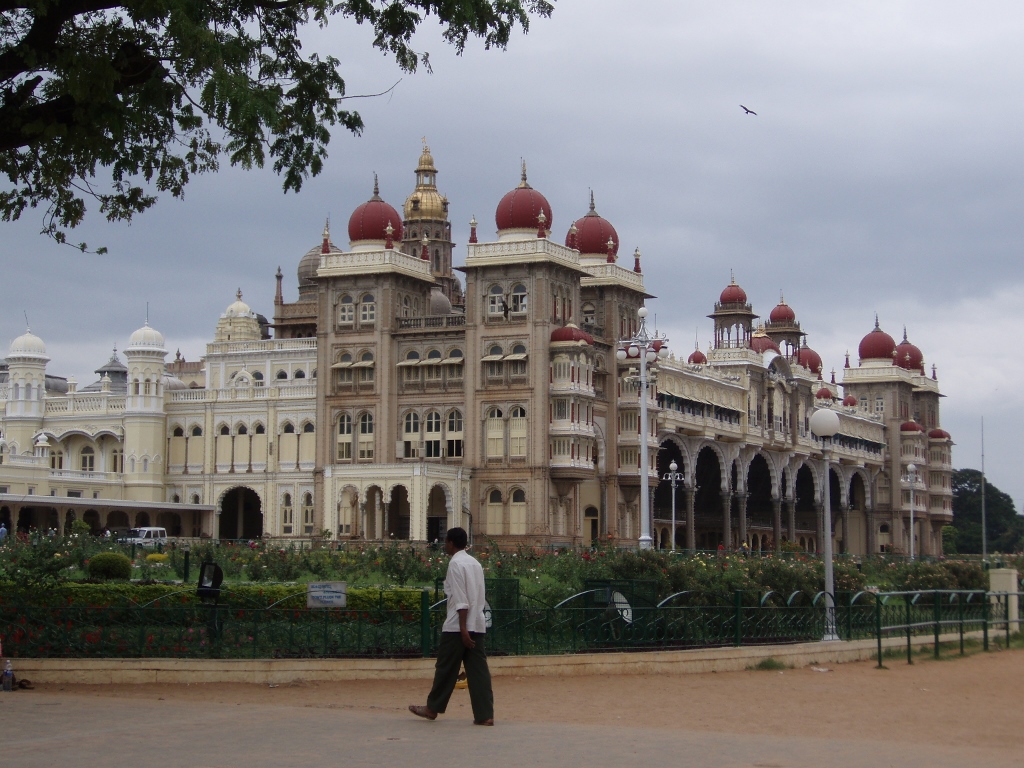 Mysore Palace; by this time it was completely clouded
Mysore Palace; by this time it was completely clouded
Although generally speaking I had no problems taking off my shoes when I wanted to visit something, I must admit that after the walk around this huge palace I had a pronounced feeling I was not clean. I guess that this was also contributed to by the fact that after the entire day of visiting sites around Hospet the previous day we also spent the night on the train. On the other hand, since I slept quite well on the train, I did not mind all of this walking.
The palace is even more impressive on the inside than on the outside, but this needs to be seen to be fully admired and I cannot offer any photos.
After our visit to the palace, we went for dinner since we had yet another night we were to spend travelling. This time, we had a coach from Mysore to the city of Kochi or Cochin in the federal state of Kerala. During our dinner, from the restaurant’s terrace we had again a view at Krishna Raja Circle.
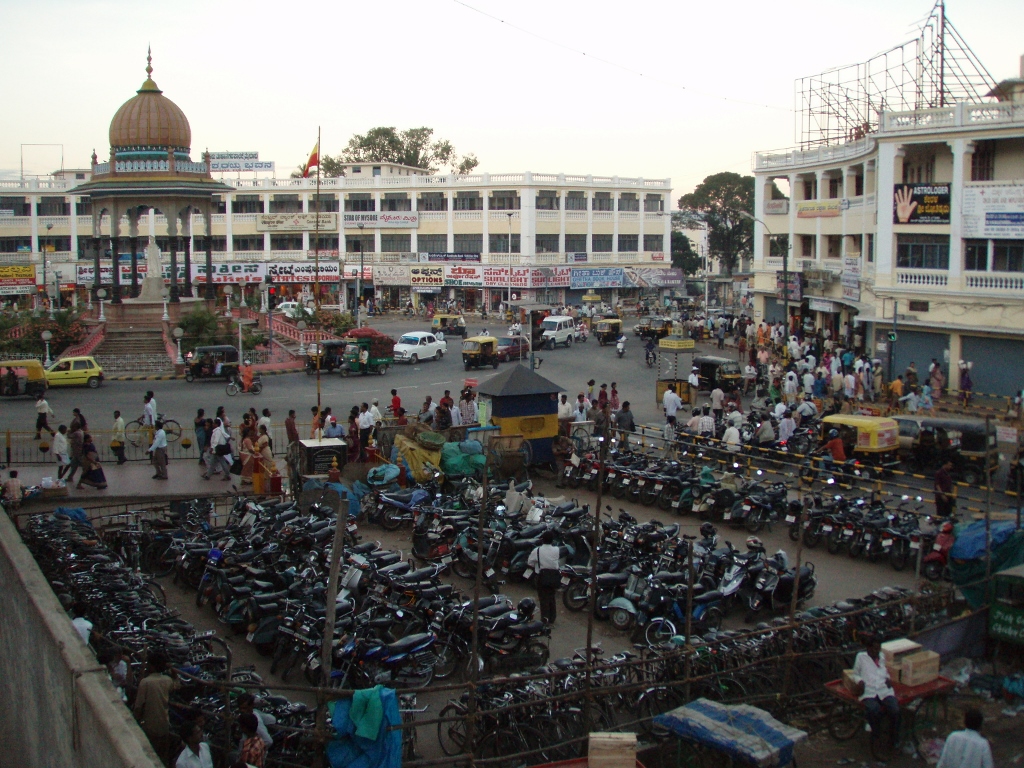 Krishna Raja Circle
Krishna Raja Circle
When we finished with our dinner, we went to the coach station to the left-luggage office where we had left our backpacks upon the arrival in Mysore. While we were waiting to take them, something strange started to happen in my belly, specifically in my intestines. I thought it would pass and so I did nothing until we took our backpacks that we then brought close to the platform from which our coach was to leave. Sneža was the first to go to the toilet and I soon regretted that I was not the first since something very serious was happening in my intestines. And very quickly. At some point Sneža returned and she tried to say something to me concerning the toilets, but I just cut her short and ran breathlessly to the toilet that was quite far from there. I panicked about whether I would get there in time. When I rushed into the female section, for a second I was taken aback because of the organisation of the space, but I managed to dart into one of the two cabins. Right on time. Of course, like always in situations like this, I felt a huge relief. Because of everything.
The reason for my initial confusion lied in the fact that the female toilet consisted of a rather big room in which there were only those two cabins in the back of the room. Everywhere around, beside the walls, on something that seemed like a raised platform there was a line of holes, but with no screen or partition of any kind.
For me, this was the first time (and the only one so far) that I found myself in such a toilet. I must admit that since I’m not used to such toilets and I come from the culture in which we all behave as if nobody ever uses them and as if we were all “above it,” it would be horribly embarrassing for me to shoot out runny stool in front of witnesses.
On the other hand, I have promised myself that the next time I find myself in such a toilet, even if there are cabins, I will bravely squat above one of such hole even if all the women squatting above their respective holes look at me. Just for the sake of an adventure and practicing how to be relaxed in all life’s situations.